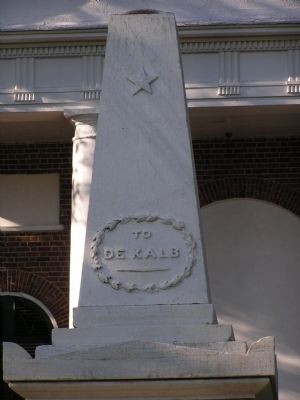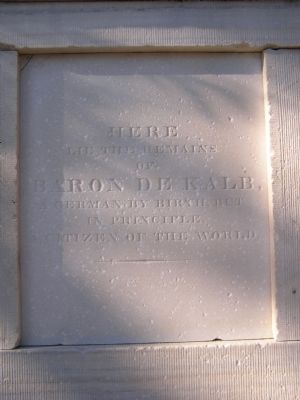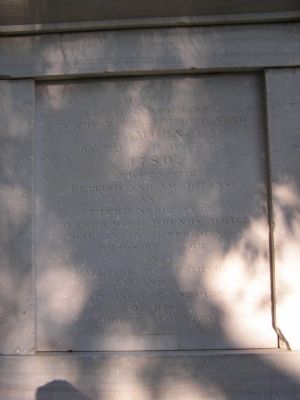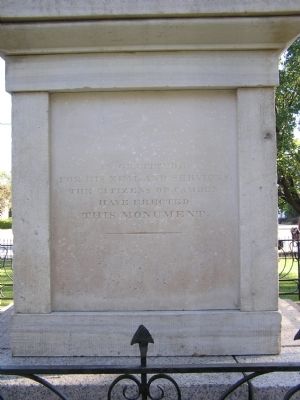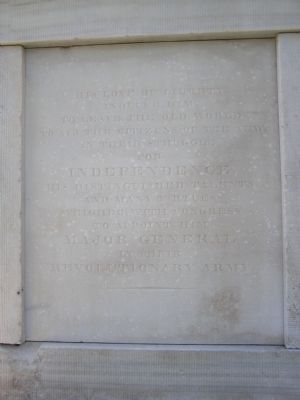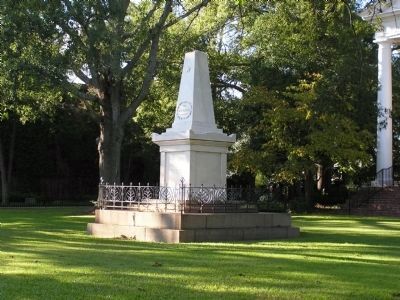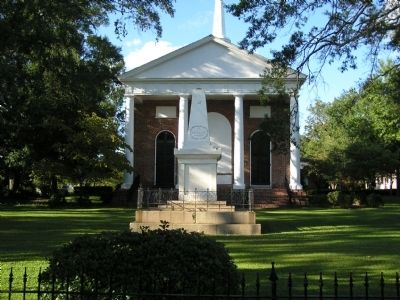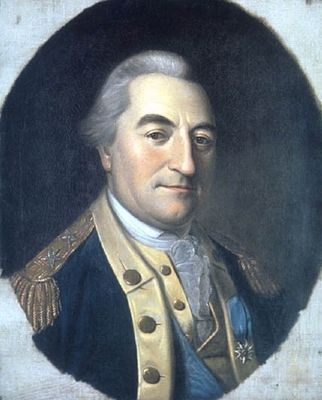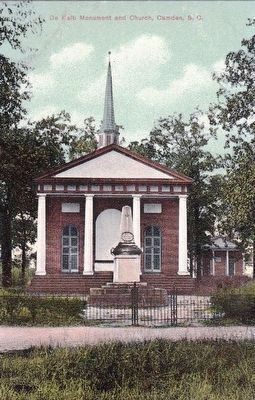Camden in Kershaw County, South Carolina — The American South (South Atlantic)
The De Kalb Monument
To De Kalb
Here lie the remains of Baron De Kalb, German by birth, but in principle, citizen of the world.
(Left Face):
He was second in command in the battle fought near Camden, on the 16th August, 1780, between the British and Americans; and there nobly fell covered with wounds, while gallantly performing deeds of valor in rallying the friend and opposing the enemies of his adopted country.
(Rear Face):
In gratitude for his zeal and services, the citizens of Camden have erected this monument.
(Right Face):
His love of liberty induced him to leave the old world to aid the citizens of the new, in their struggle for Independence. His distinguished talents and many virtues weighed with Congress to appoint him Major General in their Revolutionary Army.
Erected 1825 by The citizens of Camden.
Topics. This historical marker and monument is listed in this topic list: War, US Revolutionary. A significant historical year for this entry is 1780.
Location. 34° 14.819′ N, 80° 36.287′ W. Marker is in Camden, South Carolina, in Kershaw County. Marker is on East De Kalb Street (U.S. 1), on the right when traveling south. In the Bethesda Presbyterian Church yard. Touch for map . Marker is at or near this postal address: 502, Camden SC 29020, United States of America. Touch for directions.
Other nearby markers. At least 8 other markers are within walking distance of this marker. Lafayette's Tour (within shouting distance of this marker); E.H. Dibble Store / Eugene H. Dibble (about 800 feet away, measured in a direct line); In Honor and Remembrance (approx. 0.2 miles away); Lafayette Hall and Lafayette Cedar (approx. 0.2 miles away); Hampton Park (approx. 0.2 miles away); Richard Kirkland (approx. 0.2 miles away); Camden (approx. 0.2 miles away); Baruch Home (approx. 0.2 miles away). Touch for a list and map of all markers in Camden.
Additional commentary.
1. Baron De Kalb
Born in Huettendorf, Bavaria, the son of a peasant farmer, he attended school at Kriegenbronn before leaving home at age sixteen. He received military training in a German regiment of the French infantry in 1743. He served in the War of the Austrian Succession and the Seven Years' War. In 1763, at the battle of Wilhelmstahl, he won the Order of Military Merit. In 1768 the head of the French Foreign Ministry sent DeKalb to America on a secret mission for France to determine the extent of colonial discontent. He returned with detailed reports, but was apparently eager to return to the New World. In 1776 won a promise of a commission in the Continental Army from Silas Deane, the American commissioner to France and sailed again once more for America. He arrived in July 1777 and was appointed a major general by the Continental Congress. Second in command to the Marquis de Lafayette, he participated in a failed expedition against Canada in 1778. In April 1780 DeKalb was ordered south to relieve Charleston, South Carolina, but the city fell to the British while he was still en route. At Deep River, North Carolina he was joined by General Horatio Gates, commander of the southern department. Gates delayed an offensive until British forces became aware of his army. On August 14 the Americans marched against them at Camden. During the battle, DeKalb's horse was killed under him, and he was himself wounded eleven times. DeKalb was carried from the field and attended by Dr. Isaac Alexander. He died three days later. In March 1825 DeKalb's remains were exhumed and re-interred in the Bethesda Presbyterian Churchyard. Robert Mills, the designer of the Washington Monument, also designed DeKalb's monument. General La Fayette laid its cornerstone. The epitaph reads: ‘Here lies the remains of Baron DeKalb - A German by birth, but in principle, a citizen of the world.' Six counties in the United States are named for DeKalb, making it the third most popular name for a county in the nation. His portrait was painted posthumously by Charles Wilson Peale.
— Submitted October 4, 2011, by Anna Inbody of Columbia, South Carolina.
Credits. This page was last revised on June 16, 2016. It was originally submitted on October 4, 2011, by Anna Inbody of Columbia, South Carolina. This page has been viewed 1,300 times since then and 73 times this year. Photos: 1, 2, 3, 4, 5, 6, 7, 8. submitted on October 4, 2011, by Anna Inbody of Columbia, South Carolina. 9. submitted on October 5, 2015. • Craig Swain was the editor who published this page.
